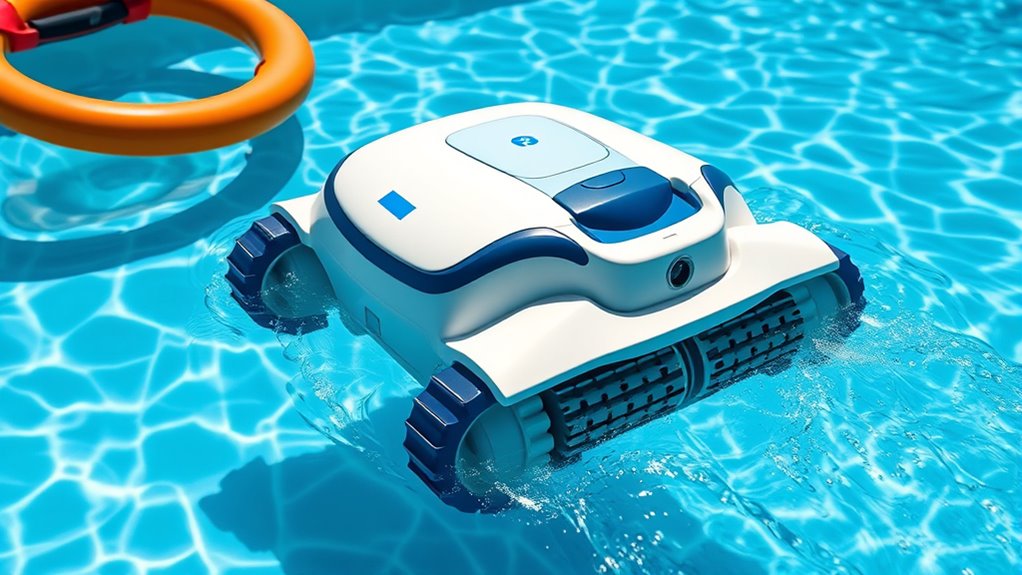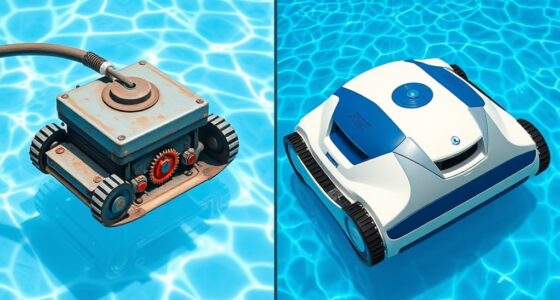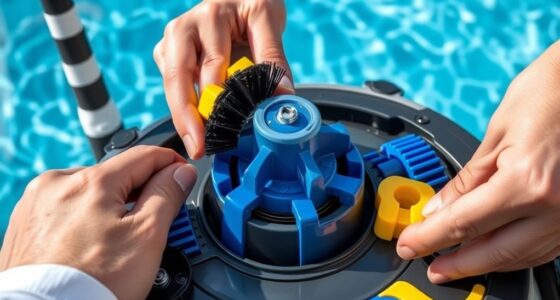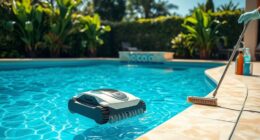To use automatic pool cleaners safely, regularly inspect and maintain your equipment, checking filters, cords, and moving parts for wear. Keep the pool area clear of obstacles like toys and furniture to prevent accidents. Always follow the manufacturer’s instructions for setup and operation. Supervise the cleaning process and keep children away during use. When not in use, store the cleaner in a dry, secure place. Continue exploring these tips for a safe and efficient cleaning routine.
Key Takeaways
- Always supervise the cleaner during operation and keep children and pets away.
- Inspect electrical cords and connections for damage before use to prevent shocks.
- Follow manufacturer instructions carefully for setup, operation, and maintenance.
- Ensure the cleaner is dry and stored properly after use to prevent mold and damage.
- Regularly check for signs of wear or damage and address issues promptly for safe functioning.
Regularly Inspect and Maintain Your Cleaner
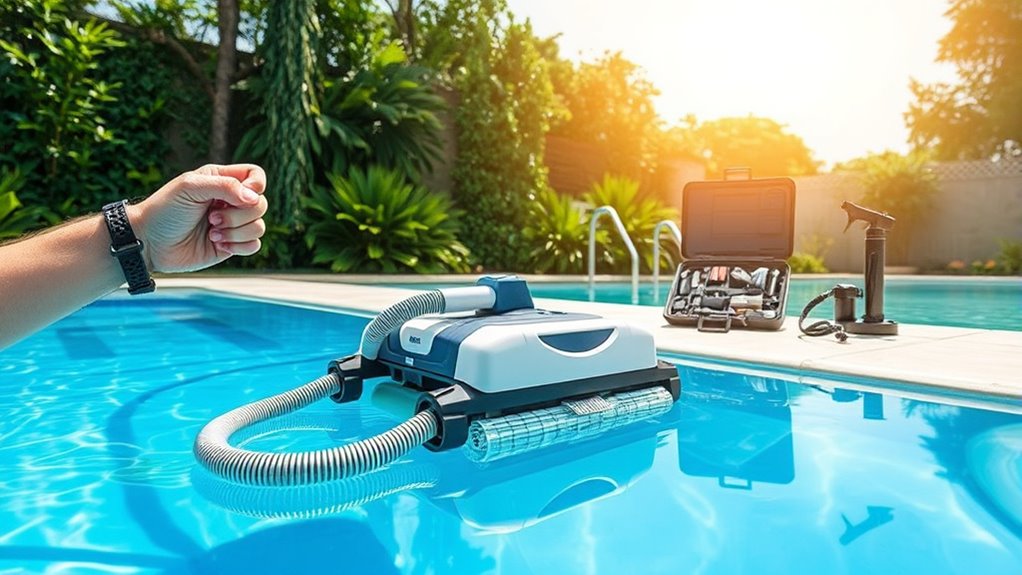
To keep your automatic pool cleaner working efficiently, you should regularly inspect and maintain it. Start by checking the filter and performing filter maintenance to ensure debris doesn’t clog the system. A clean filter improves performance and prevents motor strain. Also, inspect the power cord and connections for damage or wear, which is vital for electrical safety. Make sure the plug and outlet are dry and free from corrosion. Regular maintenance reduces the risk of electrical hazards and prolongs the cleaner’s lifespan. Keep an eye out for unusual noises or signs of malfunction, and address issues promptly. Proper care ensures safe operation and maximum efficiency, helping you enjoy a clean pool without safety concerns. Additionally, consulting the user manual and following the manufacturer’s maintenance guidelines can help identify specific care needs for your model. Incorporating routine cleaning procedures and filter checks can further enhance the longevity and safety of your automatic pool cleaner. Regularly inspecting the electrical components can prevent potential safety hazards and ensure consistent operation. Performing lubrication on moving parts can also extend the lifespan of your cleaner and maintain smooth operation.
Keep the Pool Area Clear of Obstacles
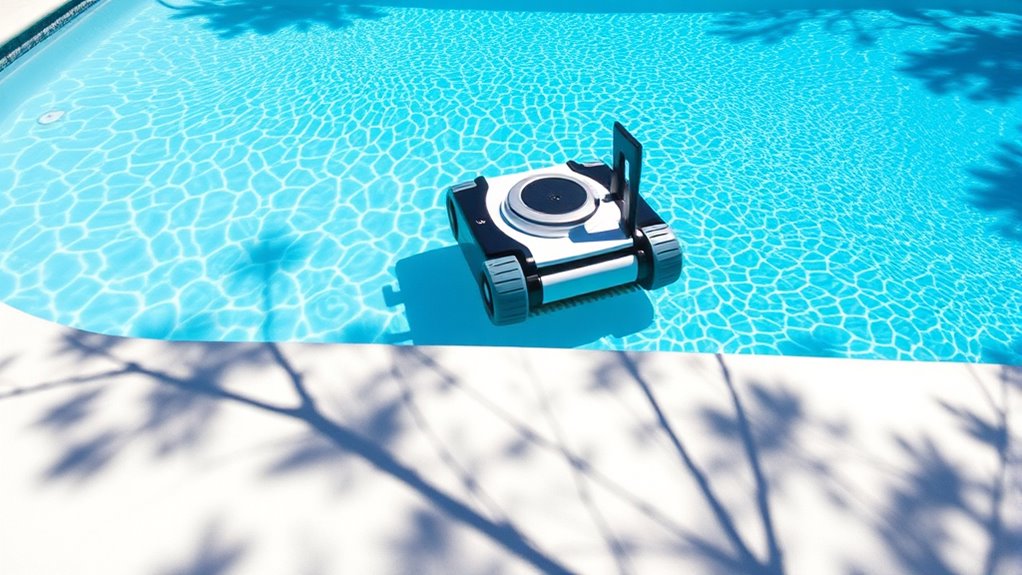
Ensuring the pool area is free of obstacles is essential for safe and efficient operation of your automatic pool cleaner. Clutter or debris can obstruct the cleaner’s path, reduce effectiveness, and create hazards. Keep the pool deck clear of pool toys, hoses, and furniture to prevent accidents. Be mindful of pool deck hazards that could trip you or damage the cleaner. Also, prioritize electrical safety by making sure power cords are tucked away and away from water. Here’s a quick guide:
| Hazard | Prevention | Reason |
|---|---|---|
| Pool toys and hoses | Store after use | Prevent tripping |
| Electrical cords | Keep away from water | Avoid electrical shock |
| Pool furniture | Move or secure during cleaning | Prevent obstruction and accidents |
| Debris on deck | Regularly sweep and clean | Reduce hazards and ensure smooth operation |
Additionally, regularly inspecting electrical safety features on your pool equipment can help prevent accidents and ensure safe usage. Properly maintaining these features can also prevent electrical hazards, safeguarding everyone around the pool area. Being aware of safety guidelines can further enhance overall safety during pool cleaning activities. Regular checks of electrical systems can detect potential issues early and maintain a safe environment. Incorporating obstacle detection technology can further improve the safety and efficiency of your automatic pool cleaner.
Follow Manufacturer Instructions Carefully
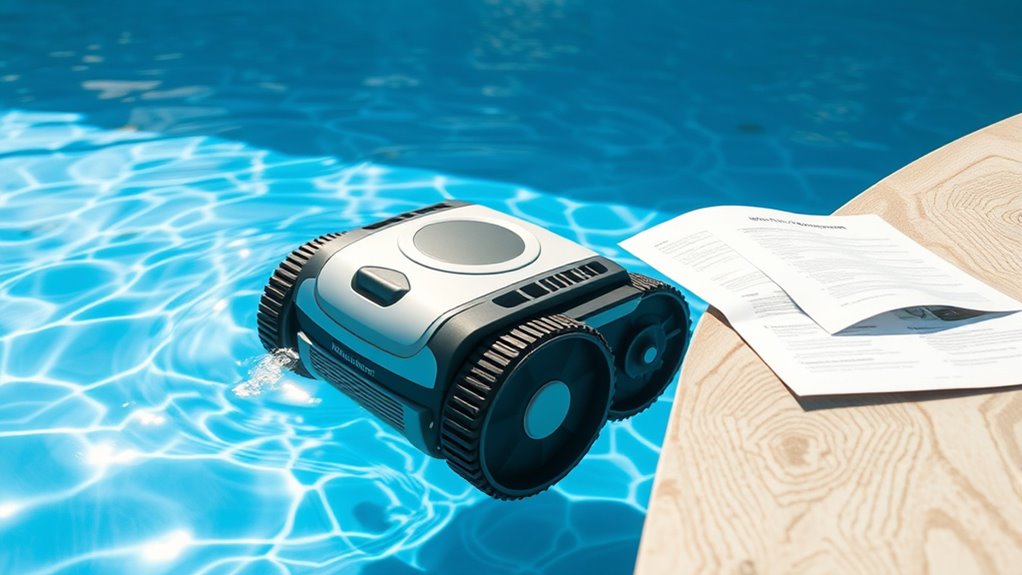
Always read and follow the manufacturer’s instructions before using your automatic pool cleaner, as each model has specific setup, operation, and maintenance requirements. This guarantees safe and effective use. Keep a maintenance checklist handy to perform routine tasks like cleaning filters and inspecting power cords regularly. Following the instructions also helps you troubleshoot common issues, such as motor problems or navigation errors, quickly and safely. Ignoring these guidelines can lead to damage or malfunctions that pose safety risks. Make sure you understand how to properly install, operate, and store your cleaner. proper use techniques are vital for preventing operational errors. Adhering to the manufacturer’s recommendations minimizes the risk of accidents and extends your cleaner’s lifespan, providing a safer and more efficient cleaning experience. Additionally, understanding water requirements can help you operate your cleaner more confidently and avoid common mistakes. Knowing electrical safety guidelines is also crucial to prevent shocks or electrical hazards during operation. Proper wall organization and secure storage of equipment can further enhance safety and prevent accidental damage to your pool cleaner.
Supervise the Cleaning Process

Supervising the cleaning process is essential to guarantee safety and proper operation. Always keep a close eye on the automatic pool cleaner while it’s working to prevent accidents. Child supervision is vital—never leave children unattended near the pool during cleaning, as they might interfere with the device or attempt to enter the water. Additionally, ensure electrical safety by checking that all cords and connections are secure and dry. Avoid handling the cleaner or plugging it in while wet to prevent electrical shocks. Stay nearby to monitor for any malfunctions or obstructions that could cause damage or hazards. Proper maintenance and regular inspections can also prevent malfunctions and prolong the lifespan of your device. Regularly inspecting and cleaning the device can enhance safety and efficiency. Recognizing signs of wear or damage early can help avoid accidents and ensure optimal performance. Being aware of device lifespan and replacement intervals can further prevent unexpected failures. Keeping the area clear of debris around the cleaner also reduces the risk of clogging or jams and helps maintain smooth operation. By supervising actively, you reduce risks and guarantee the cleaner operates efficiently, keeping your pool safe and clean for everyone.
Store the Equipment Safely When Not in Use

When the cleaning session ends, it’s important to store your automatic pool cleaner properly to preserve its condition and guarantee safety. Confirm the equipment is completely dry before storage to prevent mold and damage. Choose a secure, dry location away from direct sunlight, extreme temperatures, and moisture to maintain storage safety. Use the original storage bag or a designated container to protect the cleaner from dust and debris. Proper storage safeguards the equipment from potential hazards and reduces wear and tear, extending its lifespan. Keep the power cord neatly coiled and out of reach of children or pets. Additionally, understanding relationship patterns can help you recognize signs of neglect or issues that may need addressing to prevent future problems. By taking these steps, you ensure your automatic pool cleaner remains in excellent condition and is safe to use when needed again.
Frequently Asked Questions
Are Automatic Pool Cleaners Safe for Children and Pets?
Automatic pool cleaners can be safe for children and pets if you follow proper precautions. Always supervise young children around the pool and make certain pets aren’t near the cleaner while it’s operating. Use safety covers and barriers to prevent accidental falls. Regularly inspect the cleaner for any damage, and keep the area clear of toys or obstacles. Your vigilance helps maintain child safety and pet safety during pool cleaning.
Can Automatic Pool Cleaners Be Used During Swimming Hours?
Oh, sure, go ahead and run your automatic pool cleaner during swimming hours—what could go wrong? Just remember, for pool safety, it’s best to keep swimmers out while the cleaner works. Plus, running it during swimming hours means you risk clogging, debris, and poor cleaner maintenance. So, it’s smarter to schedule cleaning when no one’s in the water, ensuring safety and keeping your cleaner in top shape.
What Safety Gear Should I Use When Handling the Cleaner?
When handling your automatic pool cleaner, you should wear protective gloves to prevent skin irritation from chemicals or debris, and eye protection to guard against splashes or debris that might fly up. These safety gear items help you avoid potential hazards while maintaining your cleaner. Always use gloves and eye protection to guarantee a safe and comfortable experience, especially during maintenance or when troubleshooting issues with the cleaner.
How Do I Troubleshoot Safety Issues With My Cleaner?
You should regularly check your automatic pool cleaner for safety issues by inspecting for electrical safety problems and ensuring all manual maintenance is done properly. Turn off the power before troubleshooting, and look for frayed wires or damaged parts. Follow the manufacturer’s instructions carefully to prevent electrical hazards. If you notice any issues, avoid using the cleaner until repairs are complete, prioritizing safety and proper manual maintenance to keep your pool safe.
Are There Specific Safety Features to Look for in a New Cleaner?
Ever wondered what safety features your new automatic pool cleaner should have? Look for an automatic safety shutoff that activates if the cleaner gets stuck or overheats, preventing accidents. Non-slip grip handles are essential for secure handling and safe maneuvering. These features guarantee you can operate your cleaner confidently and reduce risk. Isn’t safety worth investing in? Prioritize these features for a safer, more reliable cleaning experience.
Conclusion
So, while you meticulously follow safety tips, don’t forget to actually watch your pool cleaner in action. After all, it’s just a robotic device—what could possibly go wrong? Ironically, the real danger isn’t the machine itself but overlooking simple precautions. Keep an eye on it, and your pool stays safe and spotless. Because sometimes, the biggest safety risk is thinking you’ve got everything under control without paying attention. Happy cleaning!
